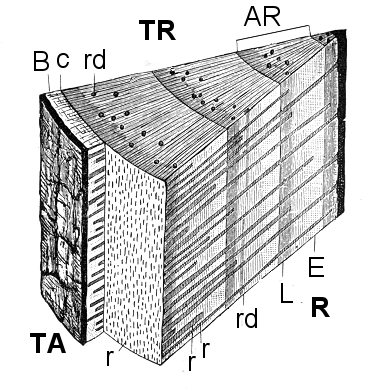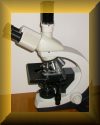Fossil gymnosperm wood
Most of the finds of petrified wood belong to this group. Examples are
the wood of the Devonian tree Archaeopteris, the Palaeozoic
wood Dadoxylon, het Mesozoic wood
Araucarioxylon and the wood of the more 'modern' conifers. |
 |
Piece of conifer wood with four annual rings.
Meaning of the letters:
B = bark
c = cambium After Strasburger (1967): Lehrbuch der Botanik |
| See the drawing above. Wood is formed by the cambium (c). This is
a layer of dividing cells, giving rise to the sieve tubes or phloem outwards
and to the (secondary) wood inwards. The cambium is only one cell thick.
In the drawing above a sector of a trunk with four annual rings has been
depicted. An annual ring (A) is the wood that is formed during one year in
an environment with seasons. In tropical conditions and in periods without
seasons (like the Jurassic and the Cretacious) the wood shows no annual
rings. In an annual ring one can distinguish the early wood (E) with
large, thinwalled cells and the late wood (L) with small, thickwalled cells.
The early wood, formed in the spring, has an important role in the transportation
of liquids in upward direction. The function of the late wood, on the other
hand, is providing stiffness to the trunk. Click
here to see an annual ring in
fossil wood from Iceland.
Conifer wood consists for more than 90% of
tracheids (wood cells). These are elongated cells
that manage the transport of water with dissolved minerals in upward direction.
The tracheids have closed (oblique) endings, and they are connected
with the adjacent tracheids through so-called bordered pits. Such a
bordered pit is a small circular area
with a hole in the middle. Through this the water can move from one cell
to another.
Bordered pits
In the wood of Araucaria and in other older kinds of gymnosperm
wood like Dadoxylon and cycas wood the bordered pits are arranged
in two or more rows. The pits of adjoining rows are now lying at different
levels: they alternate (see right picture above). Where the pits crowd together
they have a hexagonal form. This is called
araucaroid pitting. |
 |
Conifer wood from the Jurassic of Portugal
Transverse section
|